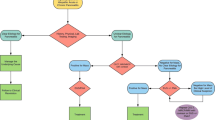Abstract
Endoscopic ultrasound-guided fine-needle aspiration biopsy (EUS-FNAB) is safe and useful for the diagnosis of pancreatic cancer. However, sometimes a diagnosis cannot be established by EUS-FNAB. The efficacy of serial pancreatic juice aspiration cytological examination (SPACE) for pancreatic cancer was reported. SPACE may be useful in cases in which diagnosis by EUS-FNAB is difficult; however, this has not been reported previously. We herein report two cases of pancreatic cancer diagnosed by SPACE when diagnosis by EUS-FNAB was difficult. Case 1 was a 77-year-old female. She was suspected of pancreatic cancer because of new-onset diabetes. We performed EUS-FNAB to the lesion in the pancreatic body; however, diagnosis failed. We performed SPACE and diagnosed pancreatic cancer finally. Case 2 was 72 years old female. She was suspected of having pancreatic cancer because of the dilatation of the pancreatic duct. We performed EUS-FNAB twice to the lesion in the pancreatic head, however, diagnosis failed. Therefore, we performed SPACE and got final diagnosis as pancreatic cancer. From our experience, we suggest that SPACE is a useful diagnostic method for patients with pancreatic cancer that are difficult to diagnose.




Similar content being viewed by others
References
Puli SR, Bechtold ML, Buxbaum JL, et al. How good is endoscopic ultrasound-guided fine-needle aspiration in diagnosing the correct etiology for a solid pancreatic mass? A meta-analysis and systematic review. Pancreas. 2013;42:20–6.
Iiboshi T, Hanada K, Fukuda T, et al. Value of cytodiagnosis using endoscopic nasopancreatic drainage for early diagnosis of pancreatic cancer: establishing a new method for the early detection of pancreatic carcinoma in situ. Pancreas. 2012;41:523–9.
Mikata R, Ishihara T, Tada M, et al. Clinical usefulness of repeated pancreatic juice cytology via endoscopic naso-pancreatic drainage tube in patients with pancreatic cancer. J Gastroenterol. 2013;48:866–73.
Siegel RL, Sahar L, Portier KM, et al. Cancer death rates in US congressional districts. CA Cancer J Clin. 2015;65:339–44.
Chen G, Liu S, Zhao Y, et al. Diagnostic accuracy of endoscopic ultrasound-guided fine-needle aspiration for pancreatic cancer: a meta-analysis. Pancreatology. 2013;13:298–304.
Suzuki R, Lee JH, Krishna SG, et al. Repeat endoscopic ultrasound-guided fine needle aspiration for solid pancreatic lesions at a tertiary referral center will alter the initial inconclusive result. J Gastrointestin Liver Dis. 2013;22:183–7.
Yamaguchi T, Shirai Y, Nakamura N, et al. Usefulness of brush cytology combined with pancreatic juice cytology in the diagnosis of pancreatic cancer: significance of pancreatic juice cytology after brushing. Pancreas. 2012;41:1225–9.
Kato S, Zakimi M, Yamada K, et al. Efficacy of repeated cytology of pancreatic juice obtained by endoscopic nasopancreatic drainage tube for early diagnosis of pancreatic cancer: a case series including a case of carcinoma in situ. Clin J Gastroenterol. 2015;8:240–6.
Funding
There is no financial support.
Author information
Authors and Affiliations
Corresponding author
Ethics declarations
Conflict of interest
We have no conflict of interest with respect to this report.
Human and animal rights
All procedures followed have been performed in accordance with the ethical standards laid down in the 1964 Declaration of Helsinki and its later amendments.
Informed consent
We obtained informed consent from the patient.
Additional information
Publisher's Note
Springer Nature remains neutral with regard to jurisdictional claims in published maps and institutional affiliations.
Rights and permissions
About this article
Cite this article
Ishikawa-Kakiya, Y., Maruyama, H., Kinoshita, Y. et al. The usefulness of serial pancreatic juice aspiration cytological examination for pancreatic cancer not diagnosed by EUS-FNAB. Clin J Gastroenterol 13, 1367–1372 (2020). https://doi.org/10.1007/s12328-020-01167-8
Received:
Accepted:
Published:
Issue Date:
DOI: https://doi.org/10.1007/s12328-020-01167-8




